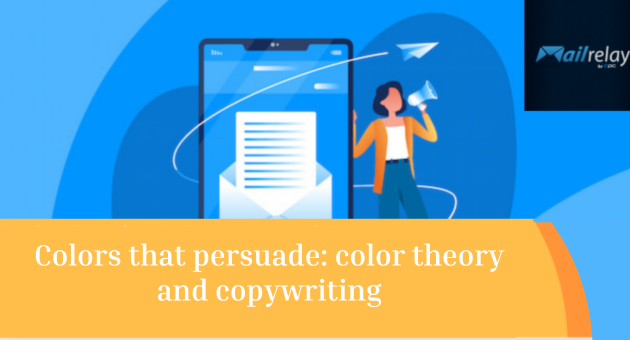
In addition to its application in art and design, color theory has found a prominent role in the digital domain.
Especially in advertising and copywriting.
The careful choice of colors can be a powerful tool for creating deeper and more persuasive connections with the audience.
Influencing everything from the effectiveness of an email campaign to the ability to discern reliable information in a content-saturated age.
In this article, we’ll explore how color theory integrates and enhances various facets of digital communication.
We’ll also look at its influence on email negotiation, offering insights into effective persuasion.
The importance of color theory in digital communication
First of all, let’s see why it’s important, as we’ll explain in the rest of the article.
📌 Generating emotional responses
Colors can affect our mood.
Therefore, we can use different colors to provoke specific emotional responses in our recipients.
By using this strategically, it is possible to reinforce the messages being conveyed, establishing a more direct and emotional connection with the audience.
📌 Creating consistent brand identities
A brand’s visual identity is usually the first thing users notice.
The effective application of color theory makes it easier to build strong, easily recognizable brand identities.
It’s a way of leaving a positive and lasting impression on users.
📌 Increase conversion rates
Can you imagine a “buy” button that blends into the background of a website?
The careful choice of colors can influence conversion rates and the level of user engagement.
Through testing and analysis, you can determine which color combinations are most appealing to your target audience, thus optimizing your digital marketing strategies.
📌 Creating credibility
Understanding color theory can help you create pages, emails and other elements that look consistent with your brand.
This way, all your corporate messages will have similar patterns, increasing credibility.
Your recipients will be more confident that they are coming from your brand.

Color theory: an overview
Color theory has been deeply integrated into many facets of our lives, from art history to modern marketing strategy.
In this section, we’ll take a panoramic view of the discipline, exploring its historical roots.
Its connection to human psychology and its vital application in the field of marketing and advertising.
💡 History and roots
To fully understand the importance and influence of color theory in the contemporary world, it is essential to go back and explore its historical roots.
From the earliest civilizations that used natural pigments to create cave art.
To modern studies that seek to decipher the science behind how we perceive colors.
The history of color theory is deeply intertwined with the history of humanity.
💡 The psychology of colors
In addition to their physical presence, colors have the remarkable ability to influence our psychology and emotions.
Color psychology focuses on the study of how different shades can affect our mood, behavior and even decisions.
We’ll see how different colors can evoke different emotional responses and how this knowledge has been used in various fields, from art to advertising.
To communicate and persuade effectively.
💡 Application in marketing and advertising
In the marketing and advertising sector, color theory is an essential tool.
By carefully selecting color palettes, brands can create visual identities that resonate with their target audience.
Transmitting specific messages to evoke the desired emotions.

Colors that persuade: the best combinations for your emails
In email negotiation, the effective implementation of color theory can make a remarkable difference.
Let’s explore practical strategies for selecting colors that build trust and for creating visual content that attracts and persuades recipients.
🎯 Color selection to build trust
Selecting the right color is a crucial step in establishing trustworthy email communication.
Some tips you can follow are:
- Blue: use shades of blue to convey professionalism and confidence. You can use it in headlines to create a positive first impression.
- Green: green, associated with growth and stability, can be used in graphics or highlights to emphasize the strengths of your proposal.
- White and grey: these colors can help keep the design clean and professional, avoiding distractions and allowing the main points to stand out more.
Remember that it is always advisable to run an A/B test with different color palettes to determine which works best with your target audience.
🎯 Creating engaging visual content
Creating engaging and effective visual content is key to selling by email.
You can consider:
- Vibrant images: use brightly colored images to grab the recipient’s attention right from the start.
- Colorful infographics: create infographics with a harmonious combination of colors to make dense information easier to understand.
- Action buttons: use eye-catching colors for call-to-action buttons, encouraging recipients to interact with the content.
- Fonts and highlights: Use contrasting colors for fonts and highlights, making it easier to read and putting emphasis on important parts of the message.
Remember that the aim is to facilitate an emotional connection with the recipient, encouraging a more productive and positive negotiation.

Increasing your sales through color theory
It will be much easier to highlight the right elements of your website with the correct use of color.
And ultimately, this will help increase your website’s sales and profits.
Let’s take a look at some important sections:
🚀 Web design and color choice
The aesthetics of your website, especially the choice of colors, can play a crucial role in influencing your visitors’ purchasing decisions.
Keep the following elements in mind:
- Attractive buy buttons: take advantage of colors that incite action when designing buy buttons. Shades such as red and orange can stimulate a quick response from users.
- Soft background: select soft, neutral background colors that highlight your products without distracting visitors.
- Use colors to show what you have to offer: For instance, you could create banners in shades that stand out, to attract shoppers to special offers or featured products.
In short, go for a soft palette for most elements of your site, such as backgrounds and content.
As for the action elements, you should look for colors that stand out from the previous ones.
🚀 Color psychology for branding
The strategic use of color can significantly influence consumers’ emotions and purchasing decisions.
Different colors can evoke a variety of emotions in people.
Below, you can see some of the emotions generally associated with some common colors:
- Red: this color can generate a sense of urgency, stimulate appetite and evoke intense emotions. It is ideal for highlighting limited offers or products on sale.
- Blue: generally associated with calm and trust, this is an excellent color for brands that want to convey reliability and serenity.
- Green: this color is associated with nature and health. It can be an excellent choice for eco-friendly products or products that promote a healthy lifestyle.
- Yellow: a color that stimulates happiness and energy, it can be used to draw attention to specific elements of a page or product.
- Orange: this color combines the energy of red with the joy of yellow, creating a feeling of enthusiasm and stimulating action.
🚀 Color scheme: basic and complementary
When planning your brand’s color palette, it’s essential to consider how the different colors interact with each other.
And how you can use these interactions to create a stronger and more engaging brand presence.
- Complementary colors: Use opposite colors on the color wheel, such as red and green, to create a strong contrast and draw attention.
- Analogous colors: for a more harmonious and cohesive effect, use colors close to each other on the color wheel.
- Contrast and saturation: experiment with different levels of contrast and saturation to highlight certain areas of your website or marketing materials.
🚀 Color perception varies with age
It’s interesting to note that color perception can change with age.
For instance:
- Young audiences: tend to prefer bright, saturated colors that convey energy and vitality. You can use bright colors and bold combinations to attract this demographic.
- Adult audience: this group may prefer softer colors and pastel shades, which convey a sense of calm and sophistication. Consider using a more neutral and elegant color palette to attract a more mature audience.

Color as a tool for manipulation
In a world where we are constantly bombarded with information, it is more important than ever to cultivate strong critical thinking.
Content creators with manipulative intentions often use color to reinforce their messages and manipulate the audience’s emotions and perceptions.
Some tactics employed include:
📣 Emotional manipulation
Color has a profound impact on our emotions and perceptions.
It can be manipulated to create a specific emotional response and sometimes distort reality.
A clear example of this is the use of the color red in news of alarm or urgency.
This color, which is associated with danger and urgency, can be used to create a sense of panic or fear, encouraging people to share news without verifying its authenticity.
▷ Real example:
In the coverage of certain media events, such as natural disasters or terrorist attacks, a predominance of red and orange tones has been observed in graphics and banners.
This often increases the perception of danger and urgency, which can lead to an emotional rather than rational response from the audience.
📣 Falsifying or altering images
Altering colors in images and videos is a technique commonly used to create false or misleading narratives.
This manipulation can range from subtle changes to significant alterations that completely change the context of an image.
▷ Real example:
A notorious case occurred during the Syrian crisis, when a photo was manipulated to change the color of a person’s clothing.
Giving the impression that they belonged to a different group, which significantly altered the narrative and the perception of the events that were taking place.
📣 Narrative definition
Color can also be used strategically to establish and reinforce certain narratives.
This can influence audience opinion on a considerable scale.
We can see how the media uses certain colors to represent different political parties, for example, which can have a subconscious impact on viewers’ perceptions.
▷ Real example:
In the political arena, the choice of colors to represent different parties can influence audience perception.
For example, in the United States, red is associated with the Republican Party and blue with the Democratic Party.
This assignment of colors is not only a way of differentiating the parties, but can also influence the way people perceive certain news stories or campaigns.
For example, during election campaigns, the media can use these colors strategically to influence audience opinion.
Either by using a party’s color predominantly in certain narratives or by using color variants (darker or lighter shades).
To evoke specific emotions and define an underlying agenda.
These cases demonstrate how the manipulation of color can play a significant role in influencing and manipulating audience perceptions.
Highlighting the need for careful critical thinking and a thorough understanding of color theory in the digital age.

Copywriting and the use of color in advertising copywriting
In the world of digital advertising, copywriting is a vital tool which, when combined with the correct application of color theory, can generate exceptional results.
We’ll also discuss the essential books for learning more about this practice.
📝 Profiles of the main copywriters and their approach to color
The artistic combination of words and colors can create visually appealing and emotionally impactful campaigns.
Some copywriters have stood out for their ability to combine these two elements masterfully.
Here are a few examples:
✓ David Ogilvy:
- Focus on color: Known as the “Father of Advertising”, Ogilvy had a holistic approach to color, using palettes that reflected a brand’s personality and values, generating a deep emotional connection with the audience.
- Notable campaigns: In his campaign for Rolls-Royce, he predominantly used black, which symbolizes elegance and exclusivity, key elements that define the brand.
✓ Seth Godin:
- Focus on color: Godin, a modern thinker in marketing, emphasizes the importance of selecting colors that tell a story, that resonate with the audience on an emotional level, creating a deeper and more meaningful connection.
- Notable campaigns: Through his collaborations with various technology brands, Godin has employed bright and bold colors, evoking a sense of innovation and modernity.
✓ Gary Halbert:
- Focus on color: Halbert, known for his direct and persuasive copywriting, also had a strategic approach to the use of color, using shades that accentuated and complemented the campaign’s central message.
- Notable campaigns: his direct response campaigns often used colors that provoked an urgent emotional response, such as red, to signal importance and urgency.
✓ Joe Sugarman:
- Focus on colors: Sugarman, famous for his persuasive copywriting techniques, also had a detailed approach to colors, using palettes that helped create trust and a welcoming environment for potential customers.
- Notable campaigns: His campaigns for electronic products often used the colors blue and green, which evoked a sense of trust and security.
These outstanding professionals demonstrated how an in-depth knowledge of color theory, combined with expert copywriting skills, can create truly impactful and memorable advertising campaigns.
📝 Essential books on copywriting and color theory
If you’re interested in delving deeper into the combination of copywriting and color theory, here are some must-read books:
- “Ogilvy on Advertising” by David Ogilvy: this book not only deals with copywriting techniques, but also provides insights into how to use color effectively in advertising.
- “Purple Cow” by Seth Godin: although not exclusively about color, it offers practical advice on how to use unique elements, such as color, to make your product stand out.
- “Color Psychology and Color Therapy” by Faber Birren: this book offers a deep dive into how different colors can affect human psychology – essential knowledge for any copywriter.
Conclusión
In the course of this article, we navigate through different facets of color theory, highlighting its significant influence in various areas of digital communication and advertising.
We saw how the conscious choice of colors can be a powerful tool in creating successful brands.
Helping to facilitate effective email negotiations.
And even how it can be employed, in certain cases, as a manipulation tool in the dissemination of fake news.
We invite you to take what you’ve learned as a starting point, a solid foundation from which you can begin to experiment and implement these strategies in your own projects.
Whether you’re starting a new online business or looking for ways to leverage your existing brand, color theory presents itself as an invaluable companion on this journey.
